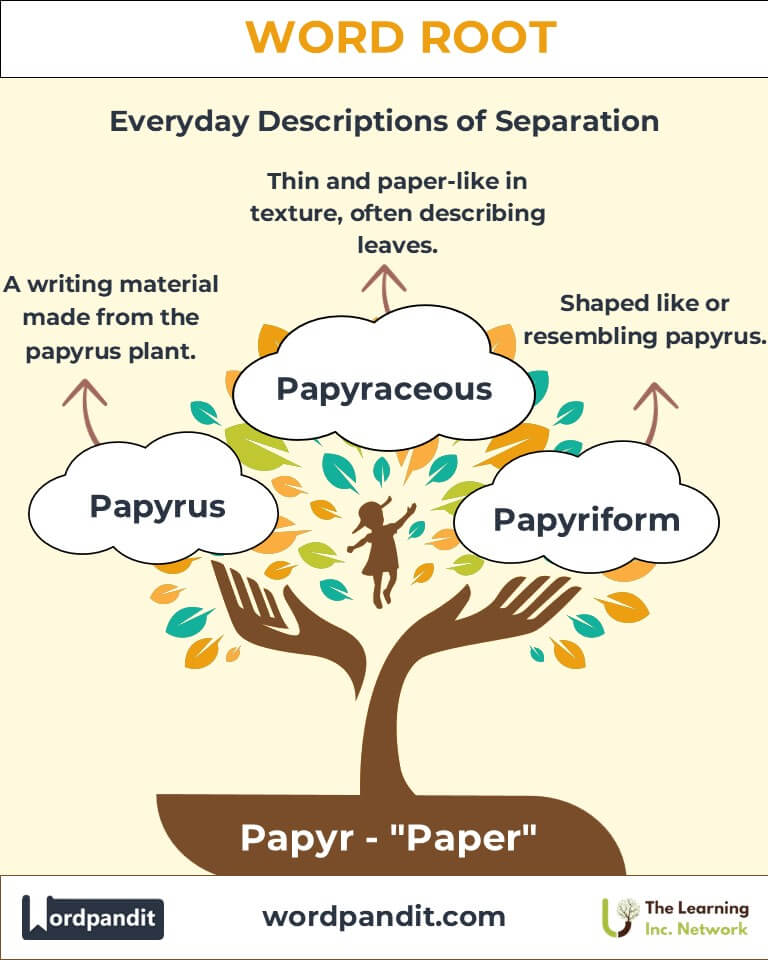Papyr: Unrolling the Ancient Roots of Paper and Writing
Discover the fascinating legacy of the root "papyr," meaning "paper." From its origins in ancient Egypt to its role in modern terminology, "papyr" has shaped the way humanity records, preserves, and communicates knowledge.

Table of Contents
- Introduction: The Essence of Papyr
- Etymology and Historical Journey
- Mnemonic: Unlocking the Power of Papyr
- Common Papyr-Related Terms
- Papyr Through Time
- Papyr in Specialized Fields
- Illustrative Story: Papyr in Action
- Cultural Significance of the Papyr Root
- The Papyr Family Tree
- FAQs about the Papyr Word Root
- Test Your Knowledge: Papyr Mastery Quiz
- Conclusion: The Living Legacy of Papyr
Introduction: The Essence of Papyr
Imagine holding a piece of papyrus, the material that sparked a revolution in writing and knowledge-sharing. The word root "papyr" (pronounced "pa-peer") originates from ancient Egyptian culture, where papyrus, a plant-based material, served as the first "paper." Today, the root symbolizes writing, documentation, and even lightweight structures in botany.

Etymology and Historical Journey
The root "papyr" derives from the Greek word papyros, which itself originated from Egyptian papuro, referring to the papyrus plant. Papyrus was vital in ancient civilizations, providing a portable medium for record-keeping, literature, and art. Over centuries, papyr evolved into the modern "paper," a term that maintains its connection to recording human history.
Mnemonic: Unlocking the Power of Papyr
To remember "papyr," picture an ancient Egyptian scribe crafting a scroll of papyrus under a golden sun.
Mnemonic Device: "Papyr preserves stories on scrolls, from the past to the present."
Common Papyr-Related Terms
- Papyrus (pa-py-rus):
Definition: A writing material made from the papyrus plant.
Example: "The archaeologists discovered an ancient papyrus scroll in the ruins." - Papyraceous (pa-py-ray-shus):
Definition: Thin and paper-like in texture, often describing certain botanical leaves.
Example: "The tree's papyraceous leaves rustled delicately in the wind." - Papyriform (pa-py-ri-form):
Definition: Shaped like or resembling papyrus.
Example: "The decorative vase had a papyriform base, inspired by Egyptian design."
Papyr Through Time
- Ancient Egypt: Papyrus was used extensively for scrolls, hieroglyphic texts, and illustrations.
- Medieval Era: Paper production techniques replaced papyrus, but its legacy persisted in the art of bookmaking.
- Modern Botany: The term "papyraceous" emerged to describe leaves or plants with paper-thin qualities.
Papyr in Specialized Fields
- Archaeology:
- Papyrus Scrolls: Invaluable for understanding ancient civilizations.
- Example: "The Dead Sea Scrolls are written on parchment and papyrus."
- Botany:
- Papyraceous Leaves: Describes thin, fragile leaves.
- Example: "Many desert plants adapt papyraceous leaves to reduce water loss."
- Design and Art History:
- Papyriform Columns: Architectural elements inspired by papyrus stalks.
- Example: "Papyriform columns are a hallmark of ancient Egyptian temple architecture."
Illustrative Story: Papyr in Action
In a small village near the Nile, young scribe Neferu was tasked with creating a scroll to record the harvest. He carefully cut and layered papyrus stalks, pressing them into a smooth surface. As he wrote, Neferu imagined how his work might one day teach future generations about life in ancient Egypt. His scrolls, preserved by time, became a treasure trove for archaeologists, embodying the enduring legacy of papyr.
Cultural Significance of the Papyr Root
The papyr root holds a deep cultural resonance as a symbol of knowledge and preservation. Papyrus enabled ancient civilizations to document history, art, and science, influencing modern writing systems and record-keeping. Its cultural significance extends to architecture, where papyriform designs celebrate its heritage.

The Papyr Family Tree
- Graph- (Greek: Writing)
- Example: Calligraphy – Beautiful writing.
- Scrip- (Latin: To write)
- Example: Manuscript – A written document.
- Libr- (Latin: Book)
- Example: Library – A collection of books.
FAQs About the Papyr Word Root
Q: What does "papyr" mean?
A: "Papyr" is derived from the word "papyrus," referring to paper or materials resembling paper. It symbolizes the ancient origins of writing and documentation using papyrus sheets, which were made from the stalks of the papyrus plant.
Q: How was papyrus made in ancient times?
A: The process involved cutting the stalks of the papyrus plant into thin strips, layering them perpendicular to each other, and pressing them to form a smooth, durable writing surface. This method made papyrus an ideal material for recording documents, art, and literature in ancient Egypt.
Q: What does "papyraceous" mean, and where is it used?
A: The term "papyraceous" describes a texture or material that is thin and delicate, similar to paper. It is commonly used in botany to describe leaves or plant parts that have a thin, lightweight quality resembling paper.
Q: What architectural elements are inspired by papyrus?
A: In ancient Egypt, columns designed to mimic the papyrus plant, known as "papyriform columns," were commonly used in temples. These columns symbolized growth, vitality, and a connection to nature in Egyptian culture.
Q: Is papyrus still used today?
A: While no longer widely used for writing, papyrus is still produced for artistic, decorative, and educational purposes. Tourists can purchase handmade papyrus sheets, and it remains a symbol of Egypt's rich cultural heritage.
Q: How is "papyr" connected to modern paper?
A: Papyrus served as the precursor to modern paper, influencing the techniques and ideas behind creating flat, portable surfaces for writing. Although paper production has advanced significantly, the root "papyr" is a linguistic reminder of this ancient innovation.
Test Your Knowledge: Papyr Word Root Quiz
1. What does the root "papyr" signify?
2. What is a papyrus?
3. What does "papyraceous" describe?
4. In which field is "papyraceous" commonly used?
5. What architectural feature is inspired by papyrus?

Conclusion: The Living Legacy of Papyr
From ancient scrolls to modern scientific descriptions, the root "papyr" continues to symbolize humanity's efforts to preserve and share knowledge. Its legacy endures in both language and culture, reminding us of the vital role that writing and preservation play in civilization.











